International Day for Disaster Risk Reduction Celebration
- International Day for Disaster Risk Reduction 2024
-
Caritas Indonesia, as one of the humanitarian actors in the country, took part in the International Day for Disaster Risk Reduction (IDDRR)celebration held in Aceh, 6-12 October 2024. The national event brought together the government officials, DRR practitioners, representations of I/NGOs, CSOs, and community, bearing the theme: Synergizing Disaster Resilience and Climate Adaptation: Inclusive and Localized Partnership Strategies as a reminder of the importance of awareness and capacity in responding to disasters.
- 1. (7 October 2024 - Simulation Rehearsal)
The simulation involving Sehati, BPBA as volunteer and representative of persons with disabilities in Aceh. Sehati give direction based on the SOP simulation book to the actors of simulation. Participant from deaf people cannot come so another person replaced them.
- 2. (8 October 2024 - DRR Month Day 1)
Caritas Indonesia and BNPB: MOU Signing with General Secretary of BNPB
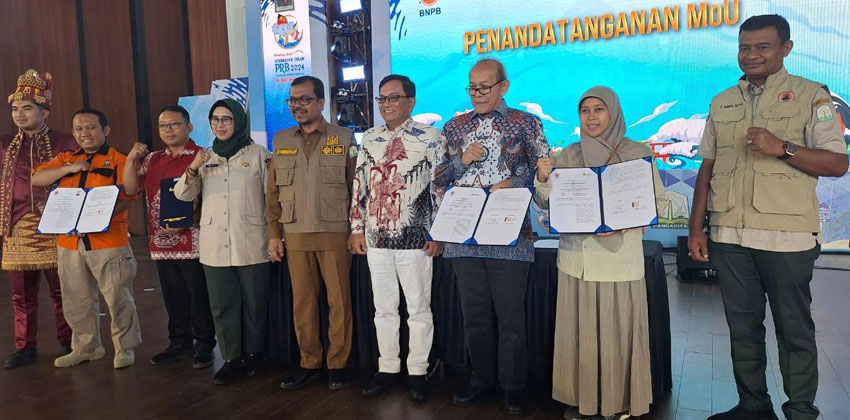
THEMATIC DISCUSSIONPresentation by SEHATI & simulation on emergency response involving persons with disabilities and elderly persons
- Launching the book on Emergency Response for Persons with Disabilities and Elderly People.
- Awareness for initiatives to build accessible resources and support towards inclusive disaster management by MPBI. The key point: an accessibility for persons with disabilities is a benchmark for accessibilities for other vulnerable groups.
- Sub-clusters have not actively involved people with disabilities.
- Organizations addressing disability issues are not focused on disability inclusion.
- There is a lack of understanding of disability inclusion among humanitarian activists.
- Meaningful engagement with the disability community is minimal.
- Questions should be directed to people with disabilities about their needs.
- Resources for addressing the challenges faced by people with disabilities are very limited.
- People with disabilities should be placed in leadership roles based on their capabilities.
- Nearly 90% of families in Indonesia have someone with a disability in their home.
- The "Sehati" program will focus on disability inclusion at the national level and in disaster management, particularly due to the high percentage of children and women affected.
- Access for people with disabilities will also improve access for those without disabilities.
- The current Sphere Handbook is not accessible due to its thickness and small font size, which limits usability for people with disabilities.
- Disaster activists working on WASH and other issues should engage more with people with disabilities and enhance their leadership roles.
- The implementation of disability inclusion is expected to develop over the next 10 years.
Talk-show on the lesson-learned from DESTANA (Inclusive Disaster Resilient Village) through the partners’ experiences – YASALTI, SEHATI, HWDI NTB, BPBD DIY
- Inclusive buildings should be accessible to many, particularly for people with disabilities, ensuring that public and social facilities are friendly to both disabilities and gender.
- Elderly health posts (posyandu) should provide health checks, nutrition, exercise, and social activities.
- Caregivers for the elderly need to understand their desires and needs to empower them.
- Data collection is crucial for program implementation.
- Disability data should be managed by social services (dinsos).
- There are established disaster response teams (destana), but the roles of the volunteers are unclear to them.
- Advocacy is being conducted to strengthen the BNPB regulation from 2012 regarding disaster response teams.
- Volunteer groups actively engage in advocacy and have secured legal recognition, leading to funding from local governments.
- We also encourage the drafting of village regulations (perdes).
- Inclusive buildings should follow universal design principles.
- There is a government regulation (PP No. 30 of 2012) addressing violence against people with disabilities.
- Specific support for victims of violence against people with disabilities has not been provided yet.
- We have established a disability information center.
- Disability data is not synchronized across regions, from province to village.
- Disability data is not synchronized across regions, from province to village.
- We are developing data collection instruments for people with disabilities to inform program development.
- Social services are mandatory for the government to provide.
- Our data collection method includes village cadres.
- Inclusion is about open access to services for people with disabilities, not just concern for their welfare.
Discussion on the initial draft of the national regulation on DRR forum
- Long-standing Questions: For years, there have been recurring inquiries about the recognition and hierarchy of disaster risk reduction forums (FPRB) within government structures.
- Challenges in Regulation: Recent attempts to establish regulations for FPRBs have faced challenges, but the focus should remain on building participatory networks rather than viewing failures as setbacks.
- Collaboration with Government: FPRBs are intended as partners to local and national governments, emphasizing collaboration over competition.
- Political Influence: Political factors can impact the establishment and functioning of FPRBs, highlighting the need for advocacy in disaster risk planning and policy development.
- Role in Disaster Management: FPRBs play a critical role in coordinating disaster response and risk reduction strategies at various levels.
- Diversity in Membership: Effective FPRBs should represent diverse stakeholders, including women and marginalized groups, and must be established with clear guidelines and representation.
- Local Variability: The structure and effectiveness of FPRBs can vary significantly between regions, influenced by local needs and resources.
- Financial Sustainability: There is a need for secure funding sources to ensure the ongoing functionality of FPRBs, with recommendations for leveraging government budgets and community contributions.
- Capacity Building: Strengthening the institutional capacity of FPRBs is essential for effective disaster risk management, including training and resources.
- Flexibility in Regulations: Regulations governing FPRBs should be adaptable to accommodate local contexts and challenges, allowing for greater responsiveness and effectiveness.
- Measurable Outcomes: Establishing clear indicators for assessing the performance and impact of FPRBs is crucial for accountability and improvement.
Overall, the discussion emphasizes the importance of collaboration, representation, sustainability, and adaptability in the effective functioning of disaster risk reduction forums.
- Session 1: Socialization of BNPB Regulation No. 2/2024 on Early Warning Systems (EWS) The session focused on the importance of early warning systems (EWS) in reducing disaster risks and enhancing public preparedness. The new BNPB regulation serves as a legal framework for the Multi-Hazard Early Warning System (MHEWS), enabling more precise, impact-based forecasting. Challenges discussed include the need for hazard-based thresholds and funding mechanisms. The session highlighted the role of BPBD in taking anticipatory actions based on EWS and the need for a national consensus on thresholds.
- Session 2: Integrating Early Warning Responses into Contingency Planning This session emphasized the integration of anticipatory actions (AA) into contingency plans, especially for hydrometeorological disasters. It addressed funding challenges, the involvement of vulnerable groups in planning, and the need to include children’s protection in evacuation protocols. Successful AA practices in NTT and Lombok were highlighted, as well as the importance of coordinating with local agencies like BPBD and BMKG. The session also stressed the significance of involving community members, including youth, in contingency planning.
- Session 3: Protecting Development Programs from Cyclone and Drought Threats This session discussed how anticipatory actions could safeguard development programs against the impacts of cyclones and droughts, especially in Papua. The Project Inclusion initiative aimed to protect agricultural livelihoods by integrating early action into project design. Meanwhile, the NOKEN project in Papua focused on promoting social cohesion to prevent conflicts. The session underscored the need for strong collaboration between local governments, communities, and external stakeholders to build resilience and protect ongoing development efforts.
- Session 4: Sharing Best Practices on Early Action Implementation Various organizations shared their experiences in implementing anticipatory actions (AA). Examples included AA for drought management in Gunung Kidul, TTU, and flood warnings in Jakarta. These practices involved local communities and authorities, using tools like community food storage and simple early warning devices. The discussion highlighted the importance of cross-sectoral collaboration and the need for policies to support AA at local levels, including the use of local knowledge in disaster preparedness.
- Session 5: Recommendations for National Dialogue on Early Action The final session focused on identifying issues and recommendations for the upcoming National Dialogue on Early Action. Key recommendations included integrating AA into social conflict management, ensuring local weather data is accessible for grassroots decision-making, and advocating for policy changes to standardize disaster thresholds. There was also a call for multi-stakeholder collaboration and the inclusion of vulnerable groups in disaster preparedness planning, along with the promotion of AA in local development plans.
-
This program aligns with the core values of Caritas Cambodia as a humanitarian organization, implementing its Disaster Risk Reduction Management Programme to enhance collective disaster preparedness, relief, and rehabilitation for those affected by natural disasters. Caritas Cambodia takes several steps outlined in the following points during emergencies.
- Caritas Cambodia collaborates with NGO partners, NCDM, PCDM, and CRC in impacted provinces to hold coordination meetings at the provincial level. These meetings discuss the emergency, prioritize the needs of affected families, identify essential materials, establish response committee structures, clarify roles and responsibilities, and develop an emergency response plan to avoid overlaps with government and other NGOs on the ground.
- The assessment team conducts field visits and engages with affected families to understand their actual needs and concerns.
- The monitoring team, consisting of Caritas Cambodia's national and provincial program staff, conducts field visits and meets with beneficiaries to discuss their experiences, how emergency materials meet their needs, and gather recommendations. They also monitor the emergency response process and prepare a brief note with recommendations, lessons learned, and improvement plans for future responses.
Here are some highlight activities that Caritas Cambodia has engaged in during 2023 and 2024 alongside government and NGO partners.
13 October 2023:The National day for Disaster Risk Reduction aims to: Showcase the Royal Government of Cambodia’s effort and policies on Disaster Management and Risk Reduction in the country. Raise public awareness on the importance of disaster management and risk reduction and mobilize stakeholders’ engagement particularly those of most vulnerable households.
Monday, 02 September 2024: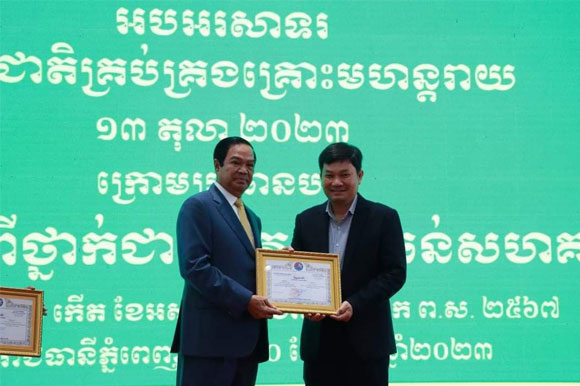
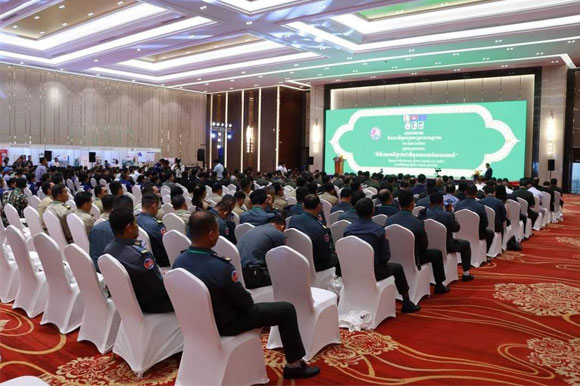
Caritas Cambodia has attended the Dissemination workshop on National Action Plan for Disaster Risk Reduction (NAP-DRR) 2024-2028 and National Contingency Plan for Flood 2024, at Le Royal hotel Phnom Penh.
27 September 2024: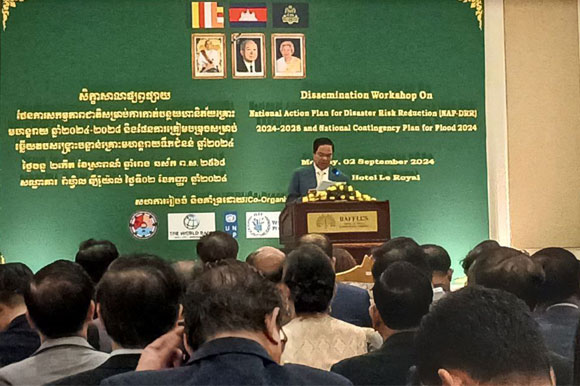
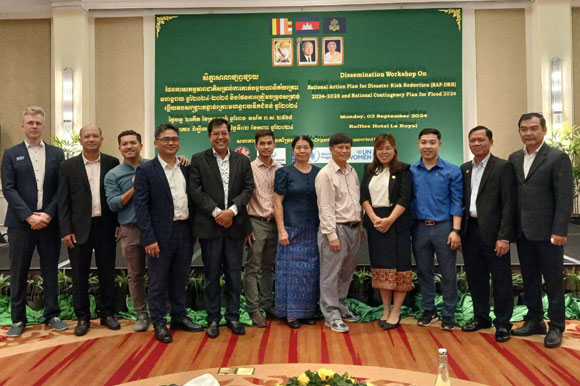
Cambodia is one of 30 other high-risk countries selected for the first EW4All initiative’s country-level kick-off activities. The initiative is coordinated by the United Nations Country Coordinator (UNRC). The United Nations World Food Programme (WFP) has been designated by the UNRC as the UN focal point to coordinate EW4All activities together with its government counterpart, the National Committee for Disaster Management (NCDM), which has been designated as the national focal point by the Royal Government of Cambodia.
Caritas Cambodia has attended the Validation workshop with the National Committee for Disaster Management (NCDM), WFP, and other international NGO around 29 partners on " the Draft Early Warning for All (EW4All) Roadmap 2024-2028." at Sun and Moon hotel, Phnom Penh, Cambodia. The aim of the workshop is Present, review and discuss the Roadmap on Early Warning for All 2024-2028 to ensure it reflects national priorities and stakeholder engagement. And Present and discuss the national coordination mechanism for the EW4ALL initiative, focusing on the structure and roles needed for effective implementation of the national roadmap.
Early warning for All (EW4All) are an effective and feasible disaster risk reduction and climate adaptation measure that saves lives and provides a tenfold return on investment. However, significant gaps in Early warning for All (EW4All) remain at global, regional and national levels, particularly when it comes to translating early warning into action to provide timely risk information.
Early Warning for All (EWAII) is a global initiative announced by the United Nations Secretary-General at the 27th Conference of the Parties (COP27) in 2022 that seeks to fill the gap in early warning systems. This important initiative aims to have every person on the planet covered by an early warning system by 2027.
The EW4All initiative includes four pillars of an early warning system, with lead agencies designated for each pillar:
- Pillar 1: Disaster Risk Knowledge (led by UNDRR) - Focuses on systematic risk data collection and risk assessment of hazards and vulnerabilities to improve risk awareness.
- Pillar 2: Identification, Observation, Monitoring, Analysis and Forecasting (led by WMO) - Focuses on developing hazard monitoring services and early warning.
- Pillar 3: Publicity and communication about information disclosure (led by ITU) - Focuses on communicating risk information, making information available to those who need it, understandable and usable.
- Pillar 4: Preparedness and Response Capacity (led by IFRC) - Focuses on building national and community response capacity.
September 20th, 2024: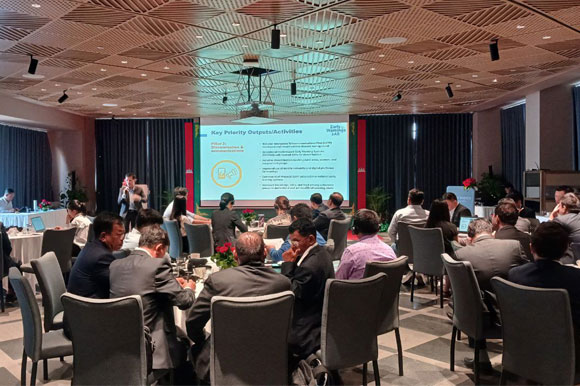
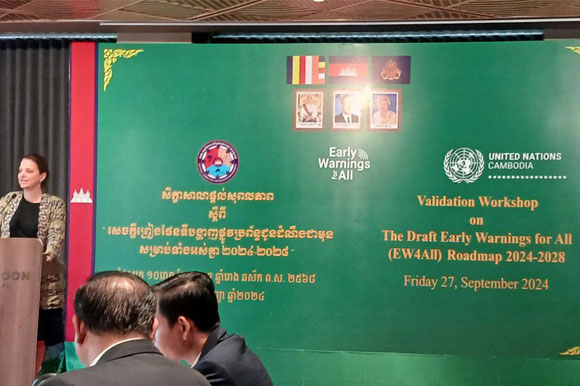
Caritas Cambodia in collaboration with CRS announced the implementation of a new joint project “Building Resilience in Communities in Cambodia” in 4 targeted communes like Reang Til, Srea Sdok, Sya and Kanhchor communes, Kandieng District, Pursat Province presided over by His Excellency Khun Sokha, Deputy Secretary General, Representative of His Excellency Dr. Kun Kim, Senior Minister, First Deputy Chairman of the NCDM. His Excellency Lay Viseth, Deputy Governor of Pursat Province, Mr. Nou Mon Sarith, Deputy Director of Caritas Cambodia and Mr. Mey Long, CRS representative.
The new project aims to disseminate to stakeholders from the national and sub-national levels, as well as relevant development partners, who are operating with a focus on disaster preparedness, especially on disasters caused by flooding.
This project is a one-year project pilot which start from July 15th, 2024, to July 14, 2025, focusing on two strategic objectives:
- Strategic Objective 1: At-risk communities effectively prepare, mitigate, and respond to reoccurring flooding and multi-hazard disaster risks.
- Strategic Objective 2: Multi-sectoral national and sub-national disaster coordination and preparedness systems effectively function so that commune disaster management committees are prepared to respond to disasters.
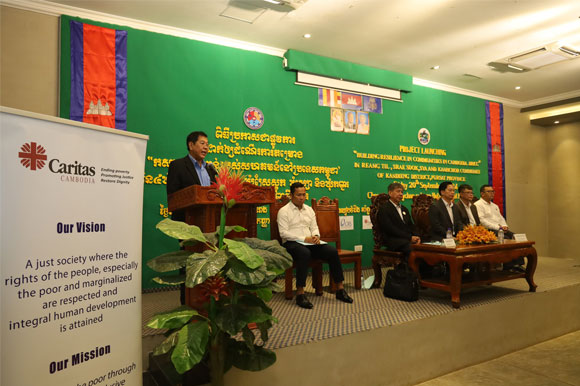
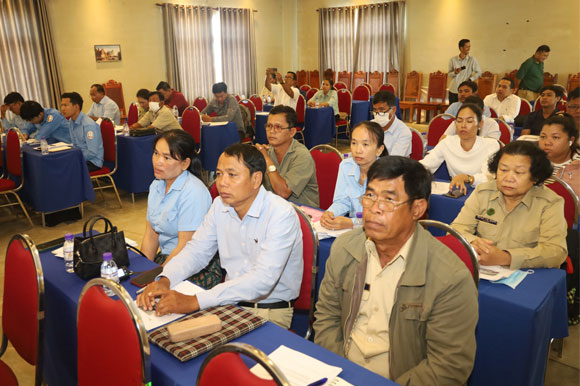
-
International Day for Disaster Risk Reduction began in 1989, after a call by the United Nations General Assembly for a day to promote a global culture of risk-awareness and disaster reduction. Held every 13 October, the day celebrates how people and communities around the world are reducing their exposure to disasters and raising awareness about the importance of reining in the risks that they face.
The focus of 2021 International Day for Disaster Risk Reduction is on Target (f) of the Sendai Framework for Action : “Substantially enhance international cooperation to developing countries through adequate and sustainable support to complement their national actions for implementation of the present Framework by 2030.”
On this note, Caritas Asia organizes a regional action with Member Organizations (MOs) to promote Caritas work in building community resilience to reduce disaster risks under the Community of Practice of SHAPE project. The idea is to highlight the fact that Caritas MOs in Asia are sustaining the efforts to build community resilience and reducing risks together with the respective communities, local leaders, authorities and various international partners amidst the global pandemic.
Click here to see the video.
